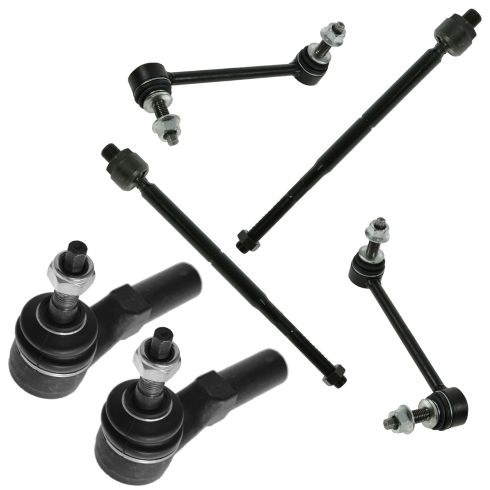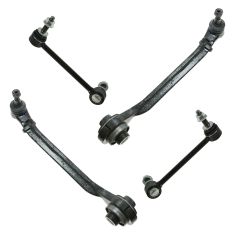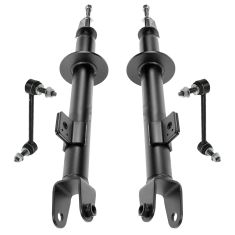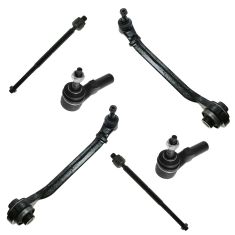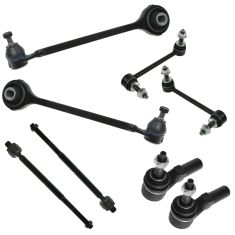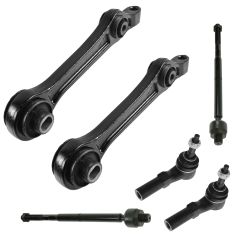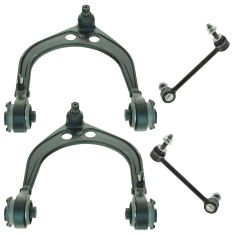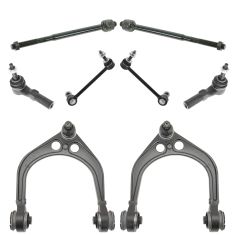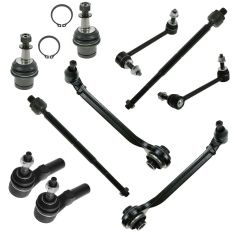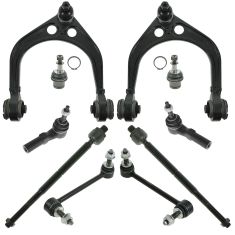Hi, I'm Mike from 1A Auto. We've been selling auto parts for over 30 years. We're dedicated to delivering quality auto parts, expert customer service, fast and free shipping, all backed by our 100% satisfaction guarantee. Visit us at 1AAuto.com, your trusted source for quality auto parts.
In this video, we're going to be working with our 2006 Chrysler 300. We're going to show you how to remove and replace the vehicle's inner tie rod which also requires the removal of the outer tie rod. We recommend you replace this at the same time. If you like this video, please click Subscribe. We have a ton more information on this and many other vehicles. If you need this part for your car, you can follow the link down in the description over to 1AAuto.com. Here are the items you'll need for this repair.
Using a 21 millimeter socket and a breaker bar, loosen all of your lug nuts about one turn. Raise and support your vehicle. We are using a lift to make it easier to show you what's going on, but this job can easily be done at home with a jack and jack stand. Remove your lug nuts the rest of the way by hand. Remove your wheel and tire.
Using the 24 millimeter wrench – and we've soaked both our jam nut and the nut on the end of the tie rod in penetrating oil – break the jam nut loose. We don't want to move it too far, just enough that it's off the end of the tie rod.
Using the 21 millimeter socket and a breaker bar, crack the nut on the end of your tie rod loose. Once you get it loose enough you may be able to finish removing it with a socket and ratchet. Now if you are removing and replacing the outer tie rod, you can use a pickle fork here, which sits between the spindle and the ball joint and knocks it out as you tap the fork in. However, that damages the boot rendering the old outer tie rod useless. So, in the interest in saving parts, we're going to use a hammer and hit the side of the spindle with a taper of the ball joint end goes through and release it. Remove your tie rod and count the number of turns it takes to remove it. It was just about 21 turns. We'll want to make sure that we install the new tie rod end that same number of rotations.
Now you'll notice that there's a hex cut on the end of your inner tie rod here, which is actually designed for a wrench to hold it. However, most open end wrenches are fairly weak and with a really stuck nut like we have on the end of our inner tie rod here, it's going to be a lot safer and easier to grab it with a pair of vice grips and spin this off with a 24 millimeter. We'll mark this flat with a paint marker. You could also mark it with a sharp chisel or punch, really anything that's just going to give you an indication of when it reaches the 12:00 position again. Five. Be sure to keep the tie rod itself steady, because this does pivot and can change the number of counts you have on that 12:00 position. Twenty-five, 26, 27, 28. It's about 28.
Using a pair of side cutters remove the clamp from the end of the tire rod boot. Now, you could also do this with a pair of pliers, but we're going to need the side cutters in the next step and I like to use the minimum amount of tools possible. Cut the old clamp off the inner edge of the boot. Sometimes you’ve got to work these ones a little bit to get them to break. Remove the boot from the rack.
Now you could get the appropriate inner tie rod tool or the right size wrench to get on to these flats and remove it. However in a pinch you can use a small pipe wrench. We set it over the end of the tie rod, tighten it up, and twist it off. Be very careful of this plastic insulator here. That's what's called a travel limiter and prevents the rack from sucking that end of the tie rod too far in and potentially damaging the seal. We want to be sure to reuse that when we install our new inner tie rod.
Here we have our old inner tie rod that we removed from our vehicle and our new part from 1AAuto.com. As you can see these parts have some minor aesthetic differences such as where the hex pattern lands on the inner tie rod in this taper here, but the important components are the same. We have the same threads on the end which are both the same length. It comes with a nice new jam nut which is good because this one was really stuck on there. You can see all the rust and corrosion that builds up. It has this little channel for keeping the bellow or the boot of the top situated exactly where it needs to be. We have the same hex on the inside here to help with installing.
You will have to remove this insulator and install it on the new part. What that does is it limits the travel of this part in and out of the rack so it doesn't get sucked in and risk damaging the seal on your rack.
What goes bad on these is this ball socket on the end which is what allows the tie rod to move and pivot as the suspension travels and the wheels turn left and right. Another reason you may replace this, other than having that socket worn out with in and outplay which you can feel when moving your tire at the 9:00 and 3:00 positions is these threads may become too corroded and not allow you to adjust your tie rods properly anymore, at which point you would want to cut that off, install a new one, and a new tie rod end on it, to make sure you can get easy and proper alignment angles.
Here we have our old tie rod end which we removed from our vehicle and our new part from 1AAuto.com. As you can see there are some minor aesthetic differences such as where the square channel is here. You either remove this with a wrench if it were to be stuck on while you're trying to get it off here in the tie rod, as well as having the grease fitting on this so you can service this and keep it greased, lubricated, and in good shape for longer. They have the same tapered end and threads, as well as a new nylon lock nut for our new part. The boots do look different but this has been bolted down and collapsed and it's been on there for almost 100,000 miles now. This is what all the boots look like when they're new and after you install it, it will closer to that.
Your tie rod end like most joints in your steering and suspension is a ball and socket joint. You can see that this one getting kind of tight, looks like there might be some rust building up down into that joint. Or these can develop play in them which will allow them to pop in and out or click side-to-side making your steering inaccurate and your alignment angles impossible to adjust, causing tire wear and handling issues. If you need to replace your tie rod end, this new part from 1A Auto is going to go in direct fit, just like your original equipment and fix you up right.
Make sure you change this travel limiter over from your old tie rod end onto this one. Be sure you can see that this one is a little worn here. This is the side that faced the rack. Be sure to mark that and put it in the same way. Once you've got it as tight as you can by hand, go ahead and finish tightening it up with your pipe wrench. You can see, this is just a small pipe wrench. I'm really not putting a ton of force on it. You'll feel where it stops on the end of those threads and doesn't want to go anymore. That'll be fine. Remove the new jam nut from the end.
We're going to use a new boot clamp on the end of our boot. However, if you don't have one of these, that's okay. You can get away with using a hose clamp for it. Set the teeth in and engage. Slide it all back in. Slide that on.
If you don't have a pair of cutters like this, which is what I use for the crimp tool, you can also get away with using an electrical crimper or a regular pair of side cutters. Just make sure you get on both sides of that fold and pinch it in. Get that as tight as you can without actually cutting into it. Make sure it stays secure.
Since we showed you the side cutter method of removing this clamp, we'll show you the other method, which is using a regular pair of pliers or lineman's pliers, pinching all three tabs together. You'll feel where this locks on to the end of the bevel. Slide that clamp on there and just let it go.
We're going to be replacing our old lock nut so we'll take our new one and just put a mark on one of the flats so we can count the same number of turns back on. Ours was just over 28. It's not going to matter if you're using the new one or the old one. We'll set that to about the 10:00 position, which is where mine came off. We'll count one, two, three, all the way up to 28.Now what we'll do is it was about 21 turns to get our tie rod on and again mine came off right around 9:00 or 10:00. We'll go ahead and get that going again and count 21 turns back on. Line up the stud on the end of your new tie rod end and insert it into your spindle.
Install your new nut. The new one is a 22 millimeter so we'll tighten that on with a 22 millimeter socket and ratchet. Torque the outer tie rod nut to 63 foot-pounds. Your new jam nut is 22 millimeter if you installed one, otherwise you'll use a 24 millimeter wrench and tighten it back down all the way against the tie rod end. Don't forget to grease the fitting until your boot swells, but does not break.
Reinstall your wheel and tire and get your 21 millimeter lug nuts as tight as you can by hand. Lower the partial weight of your vehicle back onto the tires. Torque your lug nuts to 110 foot-pounds in a cross pattern.
Thanks for watching. Visit us at 1AAuto.com for quality auto parts, fast and free shipping, and the best customer service in the industry.
